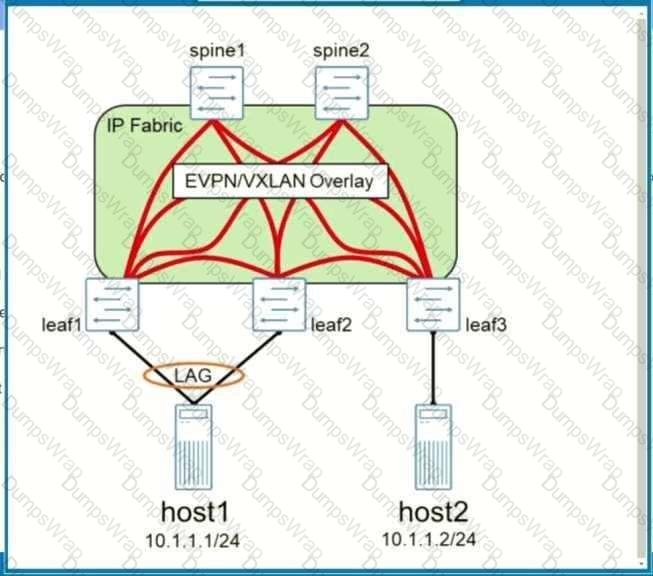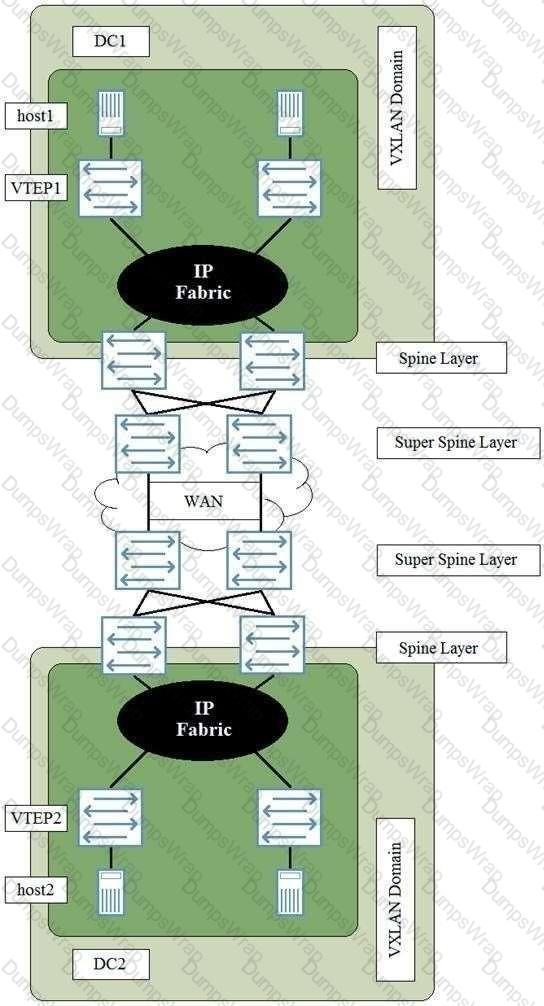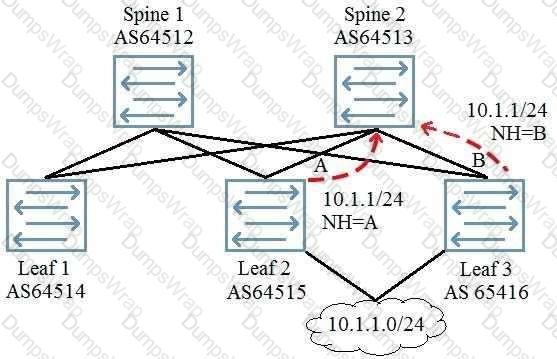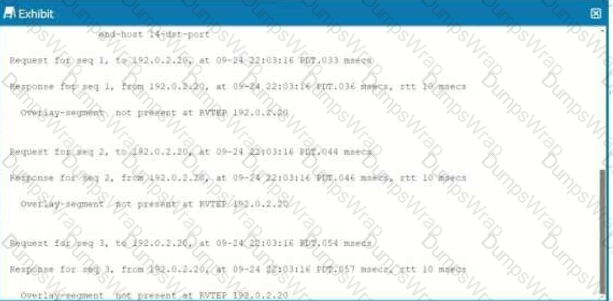Data Center Professional (JNCIP-DC) Questions and Answers
Exhibit.

You choose the EBGP fabric design as shown in the exhibit. In addition to a load-balancing policy, you want to ensure that the 10.1/16 prefix is sent to the leaf nodes.
Which two commands on the spine will accomplish this task? (Choose two.)
You are asked to design a deployment plan for a large number of QFX Series switches using
ZTP. The ZTP deployment plan must ensure all switches are configured with their designated configuration file.
Which DHCP option and subscription combination would be used to accomplish this task?
Devices spine1 and spine have been configured as distributed Layer 3 gateways in the VXLAN topology, and devices leaf1 and leaf3 have been configured as layer 2 gateways. Device host must be able to communicate with device host?

Which two statements are true? (Choose two.)
You are asked to configure your IP fabric with OSPF as the underlay routing protocol.
Which two statements are correct about this implementation? (Choose two.)
An EVPN-signaled VXLAN overlay has been deployed in the network shown in the exhibit. An EVPN LAG has been configured to connect host1 to the network, and device leaf1 has been elected as the designated forwarder.

In this scenario, which statement is true?
Application developers are complaining that east-west server traffic is not being load balanced in
your new data center. What are three reasons for this behavior? (Choose three.)
You are logged in to Leaf 1. When examining the routing table, you notice that you have no
routes from Leaf 2.

Referring to the exhibit, which two commands would you use to troubleshoot the problem? (Choosetwo.)
You are asked to manage the oversubscription ratio of your spine and leaf IP fabric. You
determine that you are at a 3:1 ratio of downstream to upstream traffic and must achieve a 1.1ratio. In this scenario, which two actions would you take to achieve this goal? (Choose two.)
Which protocol is used between VCF member devices to create a loop-free topology?
You are asked to scale the available bandwidth within your Clos data center network to support more east-west traffic. In this scenario, what are two ways to accomplish this task? (Choose two.)
Referring to the exhibit, not all routes are being exchanged by EBGP peers.

In this scenario, which BGP parameter would solve this problem?
Referring to the exhibit, DC1 and DC2 have a DCI across a service provider WAN connection. Host1 in DC1 must have Layer 2 connectivity to host2 in DC2. A VXLAN tunnel must be created between VTEP1 and VTEP2.

In this scenario, which statement is true?

Referring to the exhibit, which two statements are correct? (Choose two.)
You have deployed two data centers that require a Layer 2 stretch between host1 and host2.

Referring to the exhibit, what does a Layer 2 stretch require?
You are configuring VXLAN. and you must ensure that all switches for the multicast groups
advertise their existence and learn about other VTEPs In this scenario. which protocol will accomplish this task?
Referring to the exhibit,

which two statements are correct? (Choose two.)
You are configuring an MX Series router to act as a Layer 3 gateway to route traffic between VXLANs in different data centers across a WAN connection. In this scenario, what must you do to enable this communication?
You are asked to manage multicast traffic in the EVPN-VXLAN environment. You must ensure that multicast traffic is delivered only to the leaf device with interested receivers. In this scenario, which feature is required on leaf devices to accomplish this task?
You are asked to deploy an Ethernet bridging design in a data center with the criteria shown
below.
-Routing must occur on the spine devices.
-VTEPs must terminate on the leaf devices.
-Facilitate inter-VLAN communication.
-Layer 2 gateways must be present on spine and leaf devices.
Which architecture should you use in this scenario?
A client with five data centers spread around the country uses MPLS L2VPNs to provides point- to- point data center interconnect between each data center in a full-mesh network. The client Is considering an MPLS EVEN implementation.
In this scenario, what are three advantages of using MPL5 EVEN interconnects? (Choose two.)
You have deployed a multitenant EVPN-VXLAN fabric. You must have the routes in the BLUE VRF show up in the RED VRF.In this scenario, how would you achieve this goal?



What are two streaming data formats supported for network analytics? (Choose two.)
In an EVPN multicast environment, which two route types facilitate IGMP join and IGMP leave behavior for multihomed sites? (Choose two.)
After configuring an IP fabric using EBGP as you protocol, you notice that not all of the routers are showing up in the routing tables. You have verified that all adjacencies have formed, and place and configured properly.
In this scenario, which statement is true?
Referring to the exhibit, what would cause the problem on VCP 0/50?

You want to ensure high availability of the Junos devices in your data center. In this scenario, which three features would accomplish this task? (Choose three.)
Which two statements describe EVPN based VXLAN implementations? (Choose two.)
Referring to the exhibit, each node in the IP fabric is peering to its directly attached neighbor
using EBGP. Each node is peering using physical interface IP addresses. Leaf 2 and Leaf 3 are advertising the 10.1.1/24 network into EBGP. Spine 2 must be configured so that it can load- share traffic destined to the 10 1.1/24 network over both next-hop A and next-hop B.

Which two actions must be performed to accomplish this task? (Choose two.)
You are required to create an IP fabric for your new data center. In this scenario, which protocol would be used to support EVPN?
Referring to the exhibit,

what happens when you initiate ZTP on a QFX5120 switch running Junos
21.3R1.9?
You are troubleshooting a problem with traffic not reaching a remote VTEP. Referring to the
exhibit, what is the reason for the problem?

Referring to the exhibit, which two statements are correct?(Choose two.)

Your colleague has begun working on the base configuration for an active-active multihomed
EVPN connection shown in the exhibit.

Which two actions will ensure a successful implementation? (Choose two.)

Which statement is correct about the highlighted code segment and VXLAN frame shown in the exhibit?
You are building a new IP fabric data center underlay network and want to ensure predicted load- balancing behavior for traffic, traversing the fabric. What are two approaches you should take to satisfy the requirement in this scenario? (Choose two.)
Referring to the exhibit,

you have a data center in which only the spine devices are using EVPN and VXLAN. The leaf nodes are multihomed in active-active mode to the spine nodes through ESI LAG interfaces. In this design, a link failure on the interface connecting the spine nodes would also cause all traffic from the spine to the leaf nodes to drop.
In this scenario, which command configured on which nodes would solve this problem?
You have a data center design with multiple tenants using routing instances.
In this scenario, what are two ways to provide inter-tenant communications? (Choose two.)
Which statement is true about a Data center interconnect over an IP network?
You want to configure redundant Layer 3 gateways
In this scenario, which two juniper best practices would accomplish this task? (Choose two.)
You host a multitenant data center that runs VMware. You must perform deep packet inspection
on all inter-tenant traffic that is flowing between the VMs within the same hypervisor. Your solution must provide the security services without needing to leave the physical device. In this scenario, what should you do to solve this problem?
A VTEP requires which two interfaces? (Choose two.)
Referring to the exhibit, which statement is correct?

You are troubleshooting a connectivity issue across a VXLAN overlay network. In the exhibit, you are using the ping overlay command from a local VTEP residing on a OFX 5120 to a remote VTEP residing on a separate QFX5120.




What is the problem in this situation?
You are deploying a data center switch using ZTP. You want the switch to be upgraded to a specific software image and you want a specific configuration file applied when the switch boots with its factory default configuration.
In this scenario, which three transfer protocols will accomplish this task? (Choose three.)
You are building an IP fabric underlay network for your new data center. You must ensure that you have predictable load-balancing behavior throughout your network. According to Juniper Networks, what are two best practices that should be followed in this scenario? (Choose two.)
You are troubleshooting an L3VPN that is part of an EVPN/MPLS DCI. You notice that the EVPN overlay BGP session toward 10.29.50.4 is unable to establish.

Why is the BGP session failing to establish?

